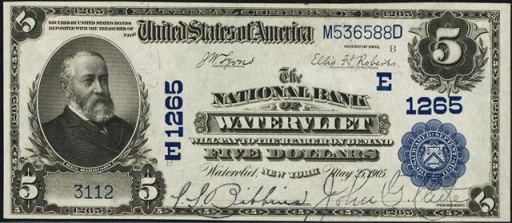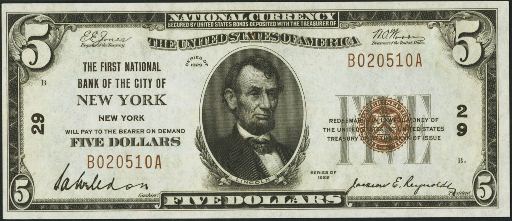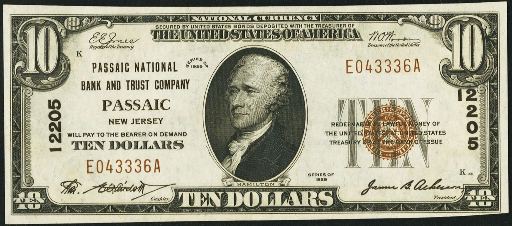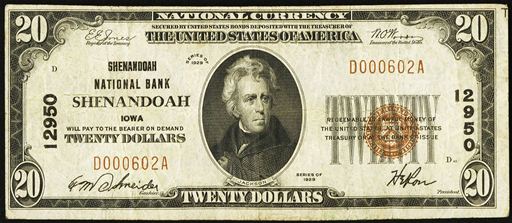The Douglass National Bank Of Chicago
The Douglass National Bank Of Chicago in Illinois printed $2,190,190 dollars worth of national currency. Over $1,000,000 face value is a lot of money. However, some types and denominations of currency from this bank could still be rare. This national bank opened in 1921 and stopped printing money in 1932, which equals a 12 year printing period. That is actually quite brief in terms of bank existence. During its life, The Douglass National Bank Of Chicago issued 4 different types and denominations of national currency. We have examples of the types listed below. Your bank note should look similar. Just the bank name will be different. For the record, The Douglass National Bank Of Chicago was located in Cook County. It was assigned charter number 12227.
We buy all national currency. Please call or email us for a quote. Sales@AntiqueMoney.com
The Douglass National Bank Of Chicago in Illinois printed 79,328 sheets of $5 1902 blue seal national bank notes. Sadly, a printing range that high means that these blue seal bank notes from this bank are not going to be extremely rare. Ben Harrison is on the front of all 1902 $5 blue seal bank notes. This happens to be the smallest denomination issued for the 1902 series. Each note is complete with a blue seal and blue charter number. Despite saying series of 1902, these were actually issued by national banks between 1908 and 1928. There are two different types of blue seals. The first type is called a date back and it has “1902-1908” written on the back of the bill. The other type is called a plain back; it does not have the date stamps on the back of the bill. The values for these notes range widely based on condition and the bank of issue.
1902 $5 Blue Seal National Bank Note
The Douglass National Bank Of Chicago printed 8,275 sheets of Type1 1929 $5 national bank notes. Sadly, based on a number that high, there is basically no chance for these notes to be especially rare. Every 1929 $5 bill has a portrait of Abraham Lincoln on it. This is also the lowest denomination of small size national currency that any bank issued. All serial numbers end with the letter A and start with a letter between A and F. Remember that you can take the total number of sheets printed and multiply it by six get to the actual number of bank notes printed for this denomination. All small size national bank notes were printed on sheets of six.
Series of 1929 Type1 $5 National Bank Note
The Douglass National Bank Of Chicago also printed 3,693 sheets of Type1 1929 $10 national bank notes. That is a pretty typical sheet output for a national bank during the small size era. Each $10 bill from 1929 has a portrait of Alexander Hamilton on it. The black number written vertically is the charter number. The charter number never affects the value; it is just an identifier. The ten dollar type1 national bank note happens to be the single most common national bank note, with over 65,000 known to exist from all banks. Of course each note is valued based on its condition and rarity. Some are very rare.
Series of 1929 Type1 $10 National Bank Note
The Douglass National Bank Of Chicago also printed 1,115 sheets of Type1 1929 $20 national bank notes. That is a pretty typical sheet output for a national bank during the small size era. Andrew Jackson is featured on the front of each 1929 $20 bill. Be sure to take note of the serial number on your specific bank note. If it is 000001 then you can expect a nice premium. There is a special market for serial number one bank notes. Of course, even if the number isn’t #1, it could still be collectible and have a high value just based on its condition and rarity alone.
Series of 1929 Type1 $20 National Bank Note



